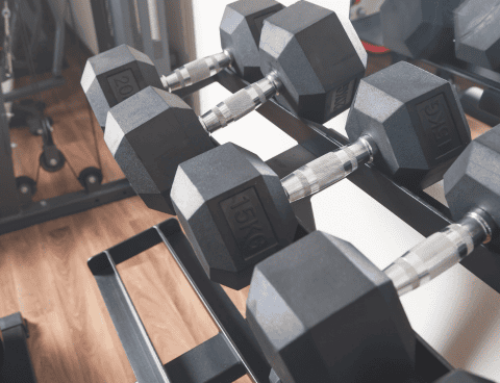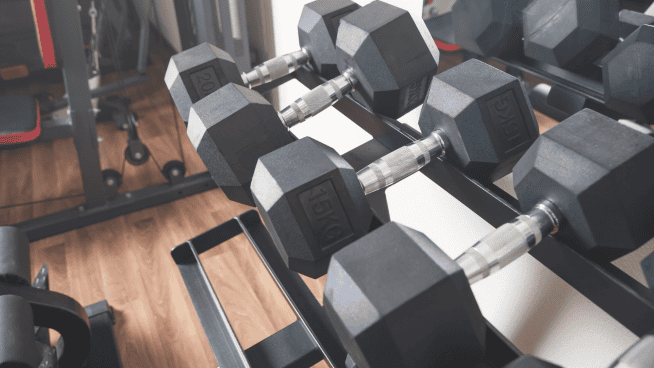French Contrast Method Program, Routines, and Exercises
The French Contrast Method is a unique and effective training program that helps you achieve higher levels of performance. This method and programming combine elements of strength, speed, and explosive exercises, similar to complex and contrast training.
Gilles Cometti, a French track and field coach, developed this unique method for athletes to reach their full potential and a greater version of themselves.
French Contrast Method, Complex, and Contrast Training
French Contrast Method, complex, and contrast training all follow the same powerful secret called post-activation potential- PAP. PAP is created when a muscle absorbs the force from a heavy load and uses it for a dynamic plyometric explosive movement. But on the other hand, their setup and process are different.
French Contrast Method
French Contrast Method is a training program that makes your strength fast and explosive. And at the same time, the program develops your power endurance. It uses four exercises that activate your fast twitch fibers by using heavy to plyometric light loads.
Complex Training
Complex training involves two exercises performing a heavy compound exercise followed by a plyometric exercise miming the same movement pattern. For example, you would squat 2-3 reps of your five-rep max or one rep of your three-rep max. Next, you would rest for 10-30 seconds and then perform 3-5 vertical jumps. This method is typically performed for three to five sets, with two to three minutes of rest between sets.
Contrast Training
Contrast training also uses two exercises. The first exercise is the same as complex training using a maximal load. However, unlike complex training, the second exercise is a drop set performed at 50-70% of the first exercise’s rep max. Rest between the exercises is about 1-2 minutes, and two to three minutes between each set.
You must comprehend complex and contrast training to maximize your potential for the French Contrast Method (FCM). There are several approaches to FCM, so let’s explore the various options to determine which works best for you.
Training is like a recipe, not a cookie cutter; it must be adjusted to achieve the best personal and individual results for you.
French Contrast Method Program
This training program consists of 4 exercises that are the same but switch from heavy to light loads. This method keeps the nervous system elevated and fast twitch fibers explosive and absorbing force, not dissipating it.
The First Exercise- Compound Movement -85-90% Load
I have experimented with many ways to do the first exercise. The best percentage to use here is 85-90 percent of your one-rep max, about five reps. Because with your five-rep max, you only want to do 2-3 reps.
Most athletes make a mistake by assuming that the more they do, the greater the neural potentiation. This is incorrect. The more repetitions you perform with a heavy load, the slower your speed. If you attempt to exhaust the fast twitch fibers by doing all the repetitions, your Golgi Tendon Organs (GTOs) will be activated.
GTOs are programmed to terminate movement to protect you from injury. GTOs will not allow muscles to absorb force and will dissipate it. Therefore, PAP will not work.
To maximize French Contrast Method results, it is important to find the right balance between heavy loads, reps, and speed. Therefore, the first exercise is to activate, stimulate, and absorb the force. So only do 2-3 reps.
Here are some other variations you can do with the first exercise.
1) You can do slow eccentric reps using 5 seconds for 2-3 reps.
2) You can hold the isometric position for 4 seconds for two reps.
3) The one that works best for me is oscillating for 3-5 reps.
You can try or do all these in different sets to train your muscles to various force factors or pick one that maximizes your training.
The Second Exercise- Reactive Dynamic Movement
This exercise will be a strict plyometric exercise. When choosing this exercise, you want it to be as sport-specific as possible. For example, vertical jumping, hurdle hops, broad jumps, or split lunge jumps. With the upper body, it can be plyometric pushups, inverted back pulls, pull-ups, etc.
The Third Exercise- Compound Movement – 50% Load
You can use the first exercise as your third, but you must lower the load by 50%. When you do the third exercise, you will start feeling fatigued, so you want to accommodate for that and lower the weight to stay fast and explosive. Remember what I said if you go too heavy, the GTOs will reduce your speed and power.
The Fourth Exercise- Assisted Reactive Movement
Because of the build-up of fatigue, you want to use assistance. So, you can use resistance bands or bars to pull on to help you maintain speed.
You must understand how the nervous system works. If you pound yourself into fatigue until the last rep of each exercise, your GTOs fire. Once they fire, you will lose the potentiation and excitation of your nervous system. As a result, it dampens speed, diminishes explosiveness, and decreases reactivity.
Use this template when putting your French Contrast Method program together.
1st Exercise-– Compound-85-90% Load – Stimulator – 2-3 reps
2nd Exercise- Reactive Dynamic – Go fast – 3-5 reps
3rd Exercise- Compound -50% Load – Go fast – 5 reps
4th Exercise- Assisted Reactive -Go fast – 5 reps
Rest 10-20 seconds between each exercise and 3 minutes after the set.
If you feel fatigued or the next rep will be slow, stop and rest and go to the next exercise. Do the number of reps that you can do fast. If it is less than 5, don’t worry. Remember, results are individually developed.
French Contrast Method Routines
For Jumping
1st Exercise– Compound- 85-90% Load
Back Squat or Leg Press
2nd Exercise- Reactive Dynamic
Vertical Jump, Hurdle Hop, Alternating Split Lunge Jump, Box Jumps, Alternating Split Box Jumps
3rd Exercise- Compound -50% Load
Dumbbell Squats, Back Squat, Kettlebell Front Squats, Sandbag Front or Back Squat
4th Exercise- Assisted Reactive
Assisted Resistance Band Vertical Jump, Split Lunge, or Box Jumps
The second and fourth exercises can be different, meaning the 2nd can be alternating split jumps and the 4th vertical jumps.
For Chest Pressing
1st Exercise– Compound-85-90% Load
Resistance Band Pushups, Bench Press
2nd Exercise- Reactive Dynamic
Plyometric Pushups
3rd Exercise- Compound -50% Load
Resistance Band Push up, Dumbbell Press
4th Exercise- Assisted Reactive
Assisted Plyometric Pushups – helping your body upwards
For Pulling
1st– Weighted Pull-up
2nd– Light Resistance- Fast Band Pulldowns
3rd -Lat Pulldowns
4th– Light Resistance Band – Speed Pulldowns
For Shoulder Pressing
1st– Push Press
2nd– Alternating Dumbbell Shoulder Presses- Lightweight
3rd– Barbell Press
4th– Dumbbell Presses -Lightweight
For Sprinting
1st– Sled Push or drag heavy for 5 seconds
2nd– Sprint 20 yards
3rd – Sled Push or drag for 5 seconds 30-50 percent less weight
4th– Resistance Band Slingshot for 10 yards or sprint 10 yards
The French Contrast Method was created to improve and boost power endurance and explosive speed. If you are unfamiliar with complex or contrast training, do those programs before you try French Contrast Method. FCM is taxing and challenging, so if your nerves and muscles don’t know how to harness PAP, you won’t get maximal results or do it correctly.
To see more routines, exercises, and programs for FCM, complex, and contrast training, check out my book, Instant Strength. And check out my YouTube channel for more methods and techniques, Balanced Body.
RECOMMENDED FOR YOU
MOST POPULAR
French Contrast Method Program, Routines, and Exercises
The French Contrast Method is a unique and effective training program that helps you achieve higher levels of performance. This method and programming combine elements of strength, speed, and explosive exercises, similar to complex and contrast training.
Gilles Cometti, a French track and field coach, developed this unique method for athletes to reach their full potential and a greater version of themselves.
French Contrast Method, Complex, and Contrast Training
French Contrast Method, complex, and contrast training all follow the same powerful secret called post-activation potential- PAP. PAP is created when a muscle absorbs the force from a heavy load and uses it for a dynamic plyometric explosive movement. But on the other hand, their setup and process are different.
French Contrast Method
French Contrast Method is a training program that makes your strength fast and explosive. And at the same time, the program develops your power endurance. It uses four exercises that activate your fast twitch fibers by using heavy to plyometric light loads.
Complex Training
Complex training involves two exercises performing a heavy compound exercise followed by a plyometric exercise miming the same movement pattern. For example, you would squat 2-3 reps of your five-rep max or one rep of your three-rep max. Next, you would rest for 10-30 seconds and then perform 3-5 vertical jumps. This method is typically performed for three to five sets, with two to three minutes of rest between sets.
Contrast Training
Contrast training also uses two exercises. The first exercise is the same as complex training using a maximal load. However, unlike complex training, the second exercise is a drop set performed at 50-70% of the first exercise’s rep max. Rest between the exercises is about 1-2 minutes, and two to three minutes between each set.
You must comprehend complex and contrast training to maximize your potential for the French Contrast Method (FCM). There are several approaches to FCM, so let’s explore the various options to determine which works best for you.
Training is like a recipe, not a cookie cutter; it must be adjusted to achieve the best personal and individual results for you.
French Contrast Method Program
This training program consists of 4 exercises that are the same but switch from heavy to light loads. This method keeps the nervous system elevated and fast twitch fibers explosive and absorbing force, not dissipating it.
The First Exercise- Compound Movement -85-90% Load
I have experimented with many ways to do the first exercise. The best percentage to use here is 85-90 percent of your one-rep max, about five reps. Because with your five-rep max, you only want to do 2-3 reps.
Most athletes make a mistake by assuming that the more they do, the greater the neural potentiation. This is incorrect. The more repetitions you perform with a heavy load, the slower your speed. If you attempt to exhaust the fast twitch fibers by doing all the repetitions, your Golgi Tendon Organs (GTOs) will be activated.
GTOs are programmed to terminate movement to protect you from injury. GTOs will not allow muscles to absorb force and will dissipate it. Therefore, PAP will not work.
To maximize French Contrast Method results, it is important to find the right balance between heavy loads, reps, and speed. Therefore, the first exercise is to activate, stimulate, and absorb the force. So only do 2-3 reps.
Here are some other variations you can do with the first exercise.
1) You can do slow eccentric reps using 5 seconds for 2-3 reps.
2) You can hold the isometric position for 4 seconds for two reps.
3) The one that works best for me is oscillating for 3-5 reps.
You can try or do all these in different sets to train your muscles to various force factors or pick one that maximizes your training.
The Second Exercise- Reactive Dynamic Movement
This exercise will be a strict plyometric exercise. When choosing this exercise, you want it to be as sport-specific as possible. For example, vertical jumping, hurdle hops, broad jumps, or split lunge jumps. With the upper body, it can be plyometric pushups, inverted back pulls, pull-ups, etc.
The Third Exercise- Compound Movement – 50% Load
You can use the first exercise as your third, but you must lower the load by 50%. When you do the third exercise, you will start feeling fatigued, so you want to accommodate for that and lower the weight to stay fast and explosive. Remember what I said if you go too heavy, the GTOs will reduce your speed and power.
The Fourth Exercise- Assisted Reactive Movement
Because of the build-up of fatigue, you want to use assistance. So, you can use resistance bands or bars to pull on to help you maintain speed.
You must understand how the nervous system works. If you pound yourself into fatigue until the last rep of each exercise, your GTOs fire. Once they fire, you will lose the potentiation and excitation of your nervous system. As a result, it dampens speed, diminishes explosiveness, and decreases reactivity.
Use this template when putting your French Contrast Method program together.
1st Exercise-– Compound-85-90% Load – Stimulator – 2-3 reps
2nd Exercise- Reactive Dynamic – Go fast – 3-5 reps
3rd Exercise- Compound -50% Load – Go fast – 5 reps
4th Exercise- Assisted Reactive -Go fast – 5 reps
Rest 10-20 seconds between each exercise and 3 minutes after the set.
If you feel fatigued or the next rep will be slow, stop and rest and go to the next exercise. Do the number of reps that you can do fast. If it is less than 5, don’t worry. Remember, results are individually developed.
French Contrast Method Routines
For Jumping
1st Exercise– Compound- 85-90% Load
Back Squat or Leg Press
2nd Exercise- Reactive Dynamic
Vertical Jump, Hurdle Hop, Alternating Split Lunge Jump, Box Jumps, Alternating Split Box Jumps
3rd Exercise- Compound -50% Load
Dumbbell Squats, Back Squat, Kettlebell Front Squats, Sandbag Front or Back Squat
4th Exercise- Assisted Reactive
Assisted Resistance Band Vertical Jump, Split Lunge, or Box Jumps
The second and fourth exercises can be different, meaning the 2nd can be alternating split jumps and the 4th vertical jumps.
For Chest Pressing
1st Exercise– Compound-85-90% Load
Resistance Band Pushups, Bench Press
2nd Exercise- Reactive Dynamic
Plyometric Pushups
3rd Exercise- Compound -50% Load
Resistance Band Push up, Dumbbell Press
4th Exercise- Assisted Reactive
Assisted Plyometric Pushups – helping your body upwards
For Pulling
1st– Weighted Pull-up
2nd– Light Resistance- Fast Band Pulldowns
3rd -Lat Pulldowns
4th– Light Resistance Band – Speed Pulldowns
For Shoulder Pressing
1st– Push Press
2nd– Alternating Dumbbell Shoulder Presses- Lightweight
3rd– Barbell Press
4th– Dumbbell Presses -Lightweight
For Sprinting
1st– Sled Push or drag heavy for 5 seconds
2nd– Sprint 20 yards
3rd – Sled Push or drag for 5 seconds 30-50 percent less weight
4th– Resistance Band Slingshot for 10 yards or sprint 10 yards
The French Contrast Method was created to improve and boost power endurance and explosive speed. If you are unfamiliar with complex or contrast training, do those programs before you try French Contrast Method. FCM is taxing and challenging, so if your nerves and muscles don’t know how to harness PAP, you won’t get maximal results or do it correctly.
To see more routines, exercises, and programs for FCM, complex, and contrast training, check out my book, Instant Strength. And check out my YouTube channel for more methods and techniques, Balanced Body.












